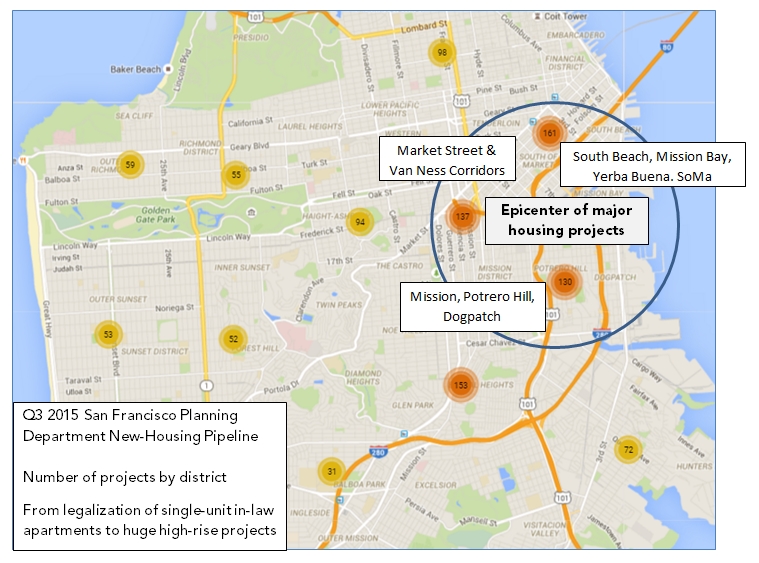The SF Planning Department just released updated Q3 information regarding the new-housing development pipeline. San Francisco is in the midst of one of its biggest new-housing construction booms in history. (The same is occurring on the commercial development side, but this report won’t deal with that.) Indeed, it often seems that new projects of one kind or another are being announced on an almost daily basis, and a detailed map delineating all projects in some stage of the pipeline makes many city districts appear to have measles.


New housing construction has lagged population pressures for decades – pressures which have soared during the current economic and employment boom – and now there is a scramble to address the inadequacy of housing supply, and, for developers/investors, to reap the rewards of a high demand/low supply dynamic in one of the most affluent and expensive housing markets in the world.
Currently, there are approximately 59,000 housing units of all kinds – luxury condos, rental apartments, market rate and affordable units, and social project housing – in the relatively near-term pipeline (next 5 to 6 years). Most are in the Market Street corridor area, the Van Ness corridor just above Market Street, and in the higher-density housing districts to the southeast of Market Street (see map). If we add the mega-projects planned for Candlestick-Hunter’s Point, Treasure Island and Park Merced, which may take decades to become a reality, the number jumps to over 80,000. As a point of context, there are approximately 382,000 residential units in San Francisco currently. About 3500 new units were added in 2014.
Housing supply and affordability issues, strong feelings regarding neighborhood gentrification and tenants’ rights, and even simple NIMBYism (or in SF, NBMVism, “not blocking my view!”) make development the most contentious political issue in San Francisco. Furious battles are ongoing in the Board of Supervisors, the Mayor’s office and the Planning Department; with neighborhood associations and special interest groups; and at the ballot box. Development is not for the faint of heart or shallow of pocket: One cannot contemplate building virtually anything in the city without vehement opposition and sometimes a well-funded coalition in opposition. For developers, the equation to be penciled out includes high costs, enormous hassle-factor and extended project timelines on one side, and the potential for large financial returns on the other. In new San Francisco developments, condos often sell for $1250 per square foot and above, and 500 square foot studio apartments can rent for up to $3500 per month.
Of the units in the greater pipeline of 80,000 units, over 9000 units are designated as “affordable housing” – but about 5000 of those are in the long-term Candlestick-Hunter’s Point and Treasure Island projects. Because of the nature of the political environment, much to do with how much affordable housing will be built is in flux. Many developers are in intense negotiations with government agencies and neighborhood associations to find a workable compromise between return on investment on one hand, and unit mix and affordable housing requirements on the other. Said requirements may consist of a percentage of units in the project, building affordable units elsewhere in the city, or contributing substantial amounts to the city’s affordable housing fund in lieu of building.
New housing construction is very sensitive to major economic, political and even environmental changes (i.e. natural disasters), so simply because something is in the pipeline doesn’t mean it will be completed as planned within the timeframe contemplated. First of all, plans are constantly being changed in the normal course of things. And if a big financial or real estate market correction (or crash) occurs, as happened in late 2008, projects in process can come to a grinding halt, and new projects substantially altered, delayed or abandoned. Because the timeline in San Francisco can run 3 to 6+ years, from initial filing with Planning to construction completion, developers and their financiers make enormous financial bets on what the future will look like. Timing is everything in real estate development, and can make the difference between exceedingly large profits and bankruptcy. When the music stops – which it always does sooner or later, though the time range of opportunity can vary greatly – not everyone will find a chair to sit down in. That especially applies to those who over-leveraged their projects.
As a side note, big Chinese developers have been investing in both large residential and commercial real estate development projects in the Bay Area, and, according to reports, continue to aggressively seek additional opportunities. Though significant – constituting billions of dollars in investment – these projects do not constitute the greater part of Bay Area development.
The Planning Department’s pipeline-report webpage is here: http://sf-planning.org/index.aspx?page=1691
And if it keeps snowing, you will find me here.


Can you double check the 28,100 number? I believe that DOES include Parkmerced, Candlestick, and Treasure Island. See socketsite: http://www.socketsite.com/archives/2015/09/the-55000-units-of-housing-in-san-franciscos-development-pipeline.html